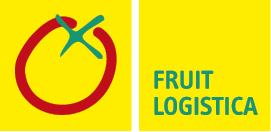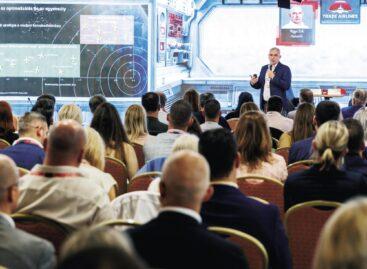Magazine: Fruit Logistica, Berlin 2019: Market advantage? It is becoming more and more difficult to achieve
 In early February more than 3,200 exhibitors from 90 countries showcased their products and services to 78,000 visitors in the four days of Fruit Logistica in Berlin. Madlen Miserius, senior product manager of Fruit Logistica told: the topics of digitalisation, climate change and Brexit have an impact on each stage of value creation. For instance the programme of the Tech Stage was all about the technologies of the future. New York-based global corporate strategy consultant firm Oliver Wyman published a study on the world’s fruit and vegetable consumption trends for Fruit Logistica. One of the company’s partners, Rainer Münch revealed in connection with the study that the fresh foods market is changing at breakneck speed. Shoppers want high-quality fruits and vegetables in every shop. Today a large supermarket offers 400-500 different fruits and vegetables.
In early February more than 3,200 exhibitors from 90 countries showcased their products and services to 78,000 visitors in the four days of Fruit Logistica in Berlin. Madlen Miserius, senior product manager of Fruit Logistica told: the topics of digitalisation, climate change and Brexit have an impact on each stage of value creation. For instance the programme of the Tech Stage was all about the technologies of the future. New York-based global corporate strategy consultant firm Oliver Wyman published a study on the world’s fruit and vegetable consumption trends for Fruit Logistica. One of the company’s partners, Rainer Münch revealed in connection with the study that the fresh foods market is changing at breakneck speed. Shoppers want high-quality fruits and vegetables in every shop. Today a large supermarket offers 400-500 different fruits and vegetables.

Anyone can download the Fruit Logistica Trend Report 2019 from www.fruitlogistica.com. The study was made with 7,000 participants in 14 countries of Europe and North America (from Central and Eastern Europe Poland took part in the survey). It forecasts that between 2015 and 2030 European consumers will spend 3 percent more on fruits and vegetables every year – this means a sum of EUR 0.8 trillion. At world level shoppers will spend 6 percent more on fruits and vegetables in a year, which results in a total spending of EUR 4.8 trillion by 2030. The study emphasises the fact that competition will be stronger in grocery retail all over the world. Thanks to this, demand will increase for higher quality fresh foods in certain regions, for which consumers will be willing to pay more.
 Online’s share keeps growing in grocery retail, but at the moment it is still at a low level. The report forecasts that by 2030 online sales of fresh fruits and vegetables will reach 7 percent. In Asia and large cities of the Western world food’s share in e-commerce is already big. A good example of this is London, where the online channel’s has a 20 percent share in grocery sales. The study also analyses the many forms of online selling, for which the supply side must prepare and react to in different ways. One of these is the multichannel format of traditional grocery retailers – these market players offer home delivery and pick-up points to collect the products purchased.
Online’s share keeps growing in grocery retail, but at the moment it is still at a low level. The report forecasts that by 2030 online sales of fresh fruits and vegetables will reach 7 percent. In Asia and large cities of the Western world food’s share in e-commerce is already big. A good example of this is London, where the online channel’s has a 20 percent share in grocery sales. The study also analyses the many forms of online selling, for which the supply side must prepare and react to in different ways. One of these is the multichannel format of traditional grocery retailers – these market players offer home delivery and pick-up points to collect the products purchased.
The authors say that online sales represent a threat to brick-and-mortar stores, but the size of this threat differs from market to market. Online-only companies that do home delivery are capable of taking away a large part of the markets of others. However, those traditional stores which are capable of surviving this period will become more profitable than they are now. Stores can react to the fiercer competition created by on line shops by taking certain steps, such as offering a larger selection of products, tracking products from farm to the dinner table, using sustainable packaging solutions, doing branding and communicating easily understandable data to consumers. //
Related news
Hungary’s food industry on the threshold of progress: the second Hungarian Food Summit
🎧 Hallgasd a cikket: Lejátszás Szünet Folytatás Leállítás Nyelv: Auto…
Read more >What’s new and new topics at FRUIT LOGISTICA 2026
🎧 Hallgasd a cikket: Lejátszás Szünet Folytatás Leállítás Nyelv: Auto…
Read more >István Nagy: campaign to promote rabbit meat consumption launched
🎧 Hallgasd a cikket: Lejátszás Szünet Folytatás Leállítás Nyelv: Auto…
Read more >Related news
How to avoid the hassles of online shopping?
🎧 Hallgasd a cikket: Lejátszás Szünet Folytatás Leállítás Nyelv: Auto…
Read more >Price isn’t enough, promotions and re(in)novation are lifting the plane
🎧 Hallgasd a cikket: Lejátszás Szünet Folytatás Leállítás Nyelv: Auto…
Read more >The preferential loan program for the SME sector also improves the situation of large companies
🎧 Hallgasd a cikket: Lejátszás Szünet Folytatás Leállítás Nyelv: Auto…
Read more >







